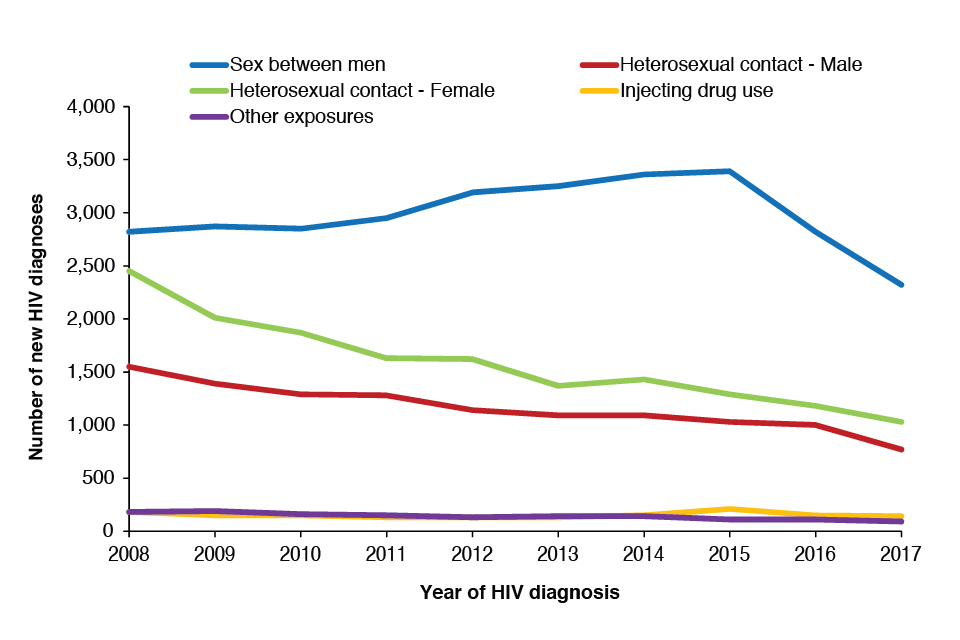HPR volume 12 issue 32: news (7 September)
Updated 21 December 2018
HIV in the UK: new diagnoses continue to fall across the country
New HIV diagnoses in the UK have fallen for the second year in a row. There were 4,363 diagnoses reported in 2017, a 17% drop from 2016, and a 28% overall drop from 2015, according to PHE’s latest annual HIV data release [1,2], summarised in this issue of the HPR [3].
The reduction was concentrated in gay and bisexual men, with numbers of new cases down 17% to 2,330 in this group in 2017 compared to 2016, and down 31% compared to 2015 (see figure). The fall in diagnoses in this group, preceded by a reduction in transmission which began in 2012, can be attributed to the high uptake of combination prevention, including large increases in HIV testing rates and improvements in the timely uptake of anti-retroviral treatment.

New HIV diagnoses by year of diagnosis and probably exposure route: UK 2008-2017
In contrast, new HIV diagnoses among people of black African and black Caribbean ethnicity have decreased steadily over the past decade from 2,655 in 2008 to 594 in 2017. And for the first time, in 2017, a fall in diagnoses was also seen in heterosexuals from other ethnicities, with a drop of 20% to 849.
Despite the promising declines, many people continue to be diagnosed at a late stage of infection (CD4 count <350 cells per cubic millimetre) with approximately 2 in 5 having had the infection for at least 3 to 5 years before diagnosis.
The new data underline the importance of early diagnosis and treatment in reducing transmission. In 2017, 93,385 people were receiving HIV-related care in the UK, with 98% (91,266/93,385) receiving antiretroviral therapy to control the virus: of those receiving ART in 2017, 97% (88,528/91,266) had untransmissable levels of virus.
PHE, alongside other government and third sector organisations, is working to control HIV by 2030 and the newly published data are an encouraging sign that this is achievable.
References
- PHE (4 September 2018). HIV annual data tables [Official statistics].
- New HIV diagnoses across the UK fell by 17% in 2017, PHE press release, 4 September 2018.
- Trends in new HIV diagnoses and people receiving HIV-related care in the United Kingdom: data to the end of December 2017, HPR 12(32) Advanced Access report, 4 September 2018.
COMEAP nitrogen dioxide report and updated statement on particulate matter
The DHSC expert advisory Committee on the Medical Effects of Air Pollutants (COMEAP) has published two new pieces of advice on quantifying mortality linked with outdoor air pollutants for use in assessing the benefits of interventions that reduce pollution levels [1,2].
On nitrogen dioxide (NO2), following 2 statements issued in 2015, COMEAP has now published a full report, having reviewed studies undertaken in a number of countries, as well as the UK, on the impact of atmospheric NO2 on public health. The report acknowledges difficulties that exist in studying the effects of individual pollutants in isolation: in particular, the health impact of particulates – often emitted from the same source as NO2 (motor traffic, for example) – leads to difficulties in accurately assessing the public health impact of NO2 pollution alone [3]. Nevertheless, the new COMEAP report presents conclusions that can be used, with caveats by policymakers.
On particulate air pollution, COMEAP has updated its previous recommendations for quantifying mortality for fine particulate air pollution (PM2.5). The updated coefficient presented is the same as previously, but the new recommendation has less statistical uncertainty associated with it.
References
- PHE (August 2018). Associations of long-term average concentrations of nitrogen dioxide with mortality.
- PHE (August 2018). Statement on quantifying mortality associated with long-term average concentrations of fine particulate matter.
- PHE (August 2018). Associations of long-term average concentrations of nitrogen dioxide with mortality (2018): COMEAP summary.
Infection reports in this issue of HPR
The following infection reports are published in this issue of HPR.
